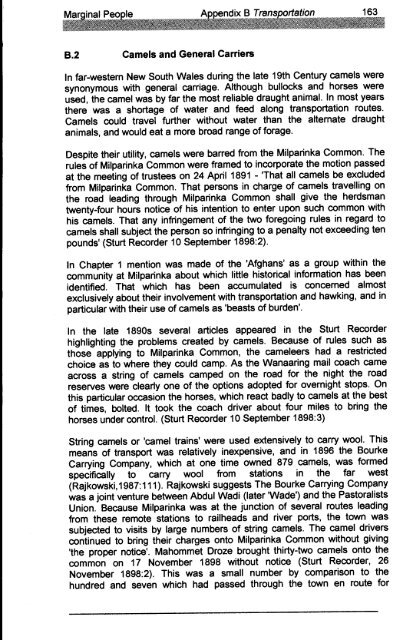Adec Preview Generated PDF File - The Sydney eScholarship ...
Adec Preview Generated PDF File - The Sydney eScholarship ...
Adec Preview Generated PDF File - The Sydney eScholarship ...
You also want an ePaper? Increase the reach of your titles
YUMPU automatically turns print PDFs into web optimized ePapers that Google loves.
B.2 Camels and General Carriers<br />
In far-western New South Wales during the late 19th Century camels were<br />
synonymous with general carriage. Although bullocks and horses were<br />
used, the camel was by far the most reliable draught animal. In most years<br />
there was a shortage of water and feed along transportation routes.<br />
Camels could travel further without water than the alternate draught<br />
animals, and would eat a more broad range of forage.<br />
Despite their utility, camels were barred from the Milparinka Common. <strong>The</strong><br />
rules of Milparinka Common were framed to incorporate the motion passed<br />
at the meeting of trustees on 24 April 1891 - 'That all camels be excluded<br />
from Milparinka Common. That persons in charge of camels travelling on<br />
the road leading through Milparinka Common shall give the herdsman<br />
twenty-four hours notice of his intention to enter upon such common with<br />
his camels. That any infringement of the two foregoing rules in regard to<br />
camels shall subject the person so infringing to a penalty not exceeding ten<br />
pounds' (Sturt Recorder 10 September 1898:2).<br />
In Chapter 1 mention was made of the 'Afghans' as a group within the<br />
community at Milparinka about which little historical information has been<br />
identified. That which has been accumulated is concerned almost<br />
exclusively about their involvement with transportation and hawking, and in<br />
particular with their use of camels as 'beasts of burden'.<br />
In the late 1890s several articles appeared in the Sturt Recorder<br />
highlighting the problems created by camels. Because of rules such as<br />
those applying to Milparinka Common, the cameleers had a restricted<br />
choice as to where they could camp. As the Wanaaring mail coach came<br />
across a string of camels camped on the road for the night the road<br />
reserves were clearly one of the options adopted for overnight stops. On<br />
this particular occasion the horses, which react badly to camels at the best<br />
of times, bolted. It took the coach driver about four miles to bring the<br />
horses under control. (Sturt Recorder 10 September 1898:3)<br />
String camels or 'camel trains' were used extensively to carry wool. This<br />
means of transport was relatively inexpensive, and in 1896 the Bourke<br />
Carrying Company, which at one time owned 879 camels, was formed<br />
specifically to carry wool from stations in the far west<br />
(Rajkowski,1987:111). Rajkowski suggests <strong>The</strong> Bourke Carrying Company<br />
was a joint venture between Abdul Wadi (later 'Wade') and the Pastoralists<br />
Union. Because Milparinka was at the junction of several routes leading<br />
from these remote stations to railheads and river ports, the town was<br />
subjected to visits by large numbers of string camels. <strong>The</strong> camel drivers<br />
continued to bring their charges onto Milparinka Common without giving<br />
'the proper notice'. Mahommet Droze brought thirty-two camels onto the<br />
common on 17 November 1898 without notice (Sturt Recorder, 26<br />
November 1898:2). This was a small number by comparison to the<br />
hundred and seven which had passed through the town en route for




